Types of Palm Trees in Florida (With Pictures and Names) – Identification Guide
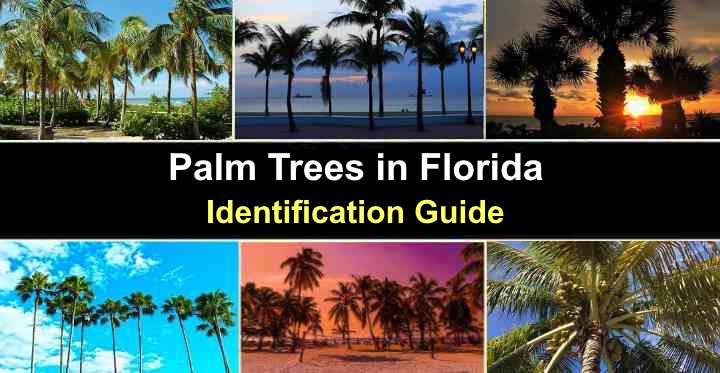
Palm trees define the Florida skyline, with various native types found throughout the state. Majestic and tall, they grace beaches, roads, and parks, while smaller varieties suit residential gardens.
Identifying the right palm tree for your area is crucial due to Florida’s diverse growing zones. Some palms tolerate light frost, while others thrive in the warm, humid climate of southern Florida. This article serves as a guide to identifying common palm trees in Florida.
Palms for Growing in Florida
Florida provides ideal conditions for growing palm trees. Palms tend to thrive in sandy soil where the climate is hot and wet in summer and cool and dry in winter.
In northern Florida, winters can have freezing temperatures and ground frost. Cold-hardy Florida native palms like Pindo palm, dwarf palmetto, Sabal palmetto, and needle palm thrive in zones 8 to 11.
In southern Florida, around Miami, cold-hardy palms also flourish. However, cold-sensitive native palms like the royal palm tree and silver palm only grow in south Florida.
Florida Palm Tree Facts
Some common native Florida palms include cabbage palms, needle palms, royal, and silver palms. Imported palms are also prevalent.
Towering Florida palms can reach 100 ft. (30 m) in height. Conversely, native dwarf palms can be as short as 20 ft. (6 m).
Types of Palm Trees in Florida (With Pictures) – Identification Guide
Here is a list of palm trees growing in Florida. In the list, you’ll discover native Florida palm trees as well as popular imported palms, all accompanied by their identification details.
Dwarf Palmetto (Sabal minor)

Dwarf palmetto is a miniature palm tree that is cold hardy
The dwarf palmetto palm is a cold-hardy Florida tree with large, blue-green fan-shaped fronds, a short fat trunk, and smooth branches. As its name suggests, it is a small palm species, typically not exceeding 3 ft. (1 m) in height.
In addition to its ornamental value, the dwarf palmetto palm offers practical benefits as well. During springtime, it produces clusters of small, yellowish-white flowers that attract important pollinators such as bees. The dwarf palmetto palm produces small, round, black fruits with a single seed. These fruits are fragrant and edible.
Its ability to thrive in a range of soil conditions, including both moist and dry soils, makes the palmetto, a versatile plant for various garden settings. Maintenance for this tree is minimal, with just the occasional removal of dead fronds.
The dwarf palmetto palm adapts to different light conditions, tolerating both light shade and full sun. This adaptability expands the possibilities for incorporating the dwarf palm into diverse outdoor spaces. It is salt and drought-tolerant, making it ideal for planting in coastal areas, dry regions, and xeriscapes.
The dwarf palmetto is a cold-hardy Florida palm that can withstand temperatures as low as 0°F (-18°C). It is suitable for residential garden landscapes in zones 7 through 10.
Florida Palm Tree Identification: The dwarf palmetto can be identified by its blue-green fronds in the shape of a fan growing on a short, smooth trunk.
USDA Zone: 7-10
Sun Exposure: Full sun to partial shade
Plant Size: 3 to 6 feet (0.9 to 1.8 meters)
Needle Palm (Rhapidophyllum hystrix)
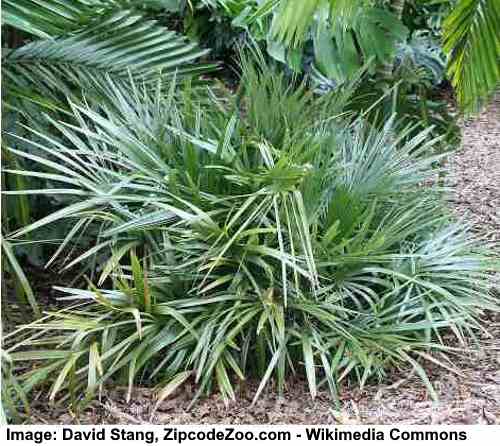
The cold hardy needle palm looks like a palm bush and is a Florida native palm
The needle palm is a short and bushy native palm tree in Florida, growing up to a height of 3 to 4 ft. (1 – 1.2 m). It is characterized by its thick trunk and deep-green fan-shaped fronds with silvery undersides, creating a rounded crown. This palm tree produces clusters of yellow-brown flowers, followed by small, fuzzy reddish-brown fruits.
The needle palm tolerates a wide range of light conditions and can thrive in various growing zones. Regular pruning is recommended to maintain its aesthetic appeal and ensure healthy growth.
This palm tree is adaptable to different soil types but prefers moist and well-drained soil. When watering the needle palm, it is important to provide adequate moisture but avoid overwatering, especially near the base. Once established, it exhibits drought tolerance.
The needle palm is exceptionally hardy, withstanding temperatures as low as 5°F (-15°C), and it thrives in USDA growing zones 6 to 10.
Florida Palm Tree Identification: Identify the short needle palm by its clumping growth of fan-like leaves, stout trunk, and rounded growth.
USDA Zone: 6-10
Sun Exposure: Full sun to partial shade
Plant Size: 3 to 4 ft. (1 to 1.2 m)
Scrub Palmetto (Sabal etonia)
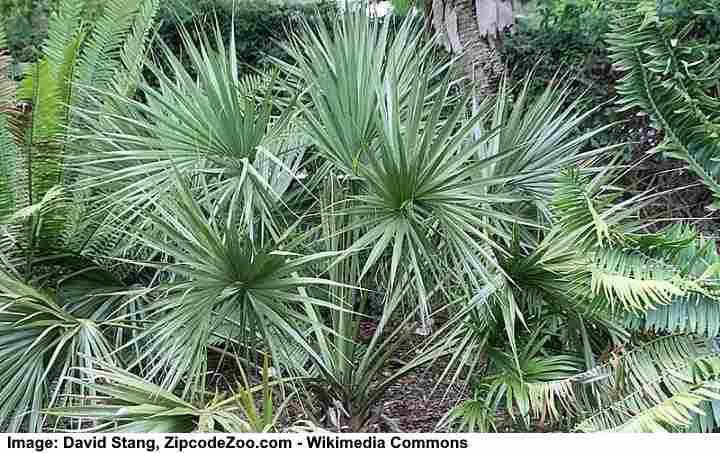
Scrub palmetto is a short palm native to Florida and is cold hardy
The scrub palmetto is a dwarf palm tree that can grow to a height of around 7 to 10 ft (2.1 to 3.0 m). While its trunk can grow up to 6.6 ft. (2 m) in height, it is typically mostly underground. It can be identified by its blue-green fan-shaped fronds that grow on a slender stem. The spiky palm leaves make it suitable for ground cover.
In spring, the scrub palmetto produces small white flowers, followed by small brownish-black fruits.
The scrub palmetto adapts well to various soil types, including both acidic and alkaline soils. However, it thrives best in soil that is kept consistently moist. Once established, the tree is drought-tolerant. It is also highly salt tolerant, making it a good choice for planting in coastal landscapes. However, it is not well-suited for flood-like conditions. It thrives when planted as an accent under large trees, providing a mix of sun and shade.
The tree requires minimal maintenance, only needing the occasional trimming of dead fronds.
The scrub palmetto is a cold-hardy palm tree native to Florida, suitable for USDA zones 8 through 11. It can withstand temperatures as low as 10°F (-12°C).
Florida Palm Tree Identification: You can identify the scrub palmetto palm tree by its thin blue-green blades growing in the shape of a fan with a slightly curved growth. It typically has between 5-8 leaves with Y-shaped tips.
USDA Zone: 8-11
Sun Exposure: Full sun to partial shade
Plant Size: 7 to 10 ft (2.1 to 3.0 m)
Saw Palmetto (Serenoa repens)

The small saw palmetto tree is suitable for limited spaces
The saw palmetto is a relatively cold-hardy small palm tree that grows throughout Florida. The identifying features of the saw palmetto are its silver-white to blue-green fan-like fronds, sharp spiky branches, and yellowish-white flowers. The saw palmetto palm reaches heights of between 7 to 10 ft. (2 to 3 m) tall. Its palm fruit consists of big dark red drupes.
In ideal conditions, the saw palmetto can also grow as a creeping ground cover form with multiple trunks and fan-shaped leaves. The plant can tolerate a range of different lighting conditions, but it performs best in full sun. Saw palmettos are slow-growing but can survive on rainfall alone and don’t require any special pruning or maintenance.
The saw palmetto prefers sandy, well-drained soil but can tolerate a wide variety of soil types. It is highly salt-tolerant and drought-tolerant once established.
This saw palmetto palm is cold hardy to 20°F (6°C) in zones 9 through 11.
Florida Palm Tree Identification: Identify the saw palmetto palm tree by a crooked stem, large silver-white to blue-green leaves with a fan-like appearance, and sharp branches.
USDA Zone: 9-11
Sun Exposure: Full sun to partial shade
Plant Size: 7 to 10 ft. (2 to 3 m)
Sylvester Palm (Phoenix sylvestris)
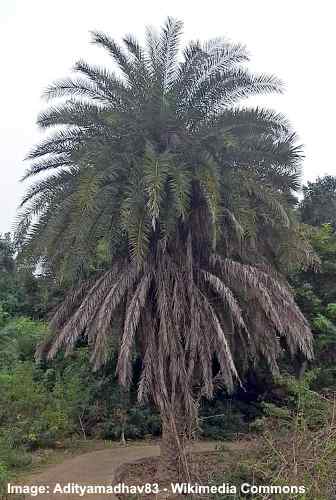
Sylvester palm is a cold hardy and slow growing tree
The Sylvester palm, also known as the silver date palm, is commonly found in Florida’s landscapes, despite not being native to the state. It is a medium-sized palm and is known for having a trunk resembling the texture of a pineapple’s skin, as well as sharp, slightly curved, blue-green leaves.
The Sylvester palm is a majestic palm tree, reaching heights ranging from 13 ft. to 50 ft. (4 – 15 m). It boasts a leafy crown that spans 32 ft. (10 m) in both width and height. The palm tree produces small, yellowish-white flowers that emerge on branches located beneath its crown. Over time, these flowers develop into delectable, edible dates.
Sylvester palms are resilient to drought, have a slow growth rate, and exhibit strong cold hardiness. They require a significant amount of sunlight to thrive but can also tolerate some shade. In addition, they are also relatively low-maintenance, requiring only the pruning of dead fronds to maintain their aesthetic.
The Sylvester palm tolerates a range of different soil types but grows best in sandy, well-drained soil.
Sylvester palms grow in all parts of Florida in zones 8b through 11.
Florida Palm Tree Identification: The Sylvester palm is identified by its sharp, stiff, pointed blue-green leaves, rough fibrous trunk, and vast bushy palm crown.
USDA Zone: 8b-11
Sun Exposure: Full sun to partial shade
Plant Size: 13 to 50 ft. (4 to 15 m)
Key thatch palm (Leucothrinax morrisii)
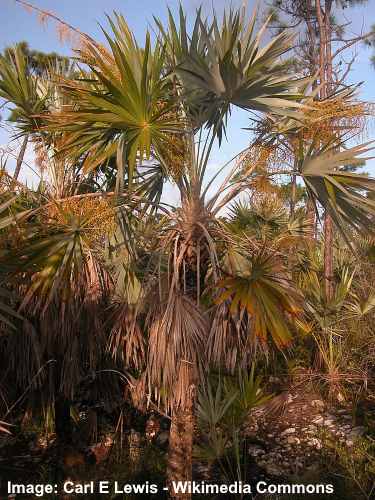
The Keys thatch palm is native to the Florida Keys and can vary in size depending on growing conditions
The Florida native key thatch palm, also known as brittle thatch palm, is a small-to-medium-sized palm known for its yellow-green to blue-green fan-shaped (palmate) leaves that grow on a single long stem. The leaves feature long leaflets, reaching up to 2.5 ft. (0.7 m) in length. Depending on the growing conditions, the tree itself can range from a small size, reaching only 3 ft. tall (1 m), to a tall and graceful palm tree that soars over 36 ft. (11 m) in height. The palm produces small, whitish-yellow flowers and round, white drupes.
The key thatch palm can be grown in full sun or partial shade, and thrives in well-drained, moist soil. Once established, it exhibits both drought and salt tolerance.
The key thatch palm is tolerant of wind and some frost and is cold-hardy to 30°F (-1°C), thriving in USDA zones 9 to 11.
Florida Palm Tree Identification: The key thatch palm is recognized by its substantial spiky foliage growing on multiple branches, a fibrous trunk, and small white fruits.
USDA Zone: 9-11
Sun Exposure: Full sun to partial shade
Plant Size: 3 to 36 ft. (1 to 11 m)
Florida Thatch Palm (Thrinax radiata)
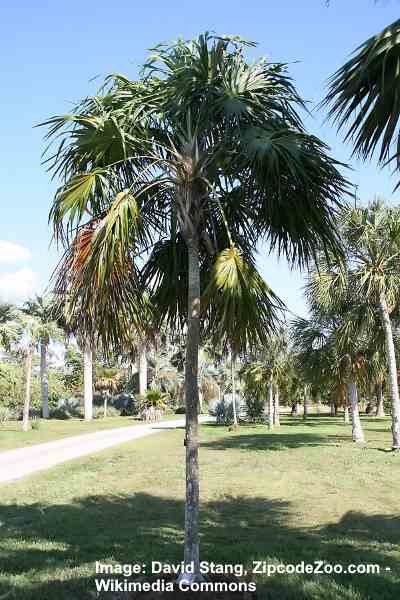
Florida Thatch Palm is grown in South Florida and is identified by its skinny trunk
The Florida thatch palm is a small tree with a single slender trunk and crown of yellow-green, palmate leaves. These cold-sensitive palms grow well in coastal regions and are excellent for garden landscapes or growing in containers. The slow-growing southern palms grow up to 20 ft. (6 m) tall. The palm tree produces petite white flowers that emerge on stalks, eventually giving way to small, round, white fruits.
The Florida thatch palm is both salt and drought-tolerant and grows best in sandy, well-drained soil. It thrives in full sun, but can also tolerate partial shade. Additionally, it is not self-cleaning, so you will need to prune dead fronds a couple of times a year.
The Florida thatch palm is suitable for growing in South Florida as it thrives in USDA zones 10 and 11.
Florida Palm Tree Identification: The Florida thatch palm tree is a skinny palm tree with between 10 and 20 green palmate leaves forming a canopy.
USDA Zone: 10-11
Sun Exposure: Full sun to partial shade
Plant Size: Up to 20 ft. (6 m)
Bismarck Palm (Bismarckia nobilis)
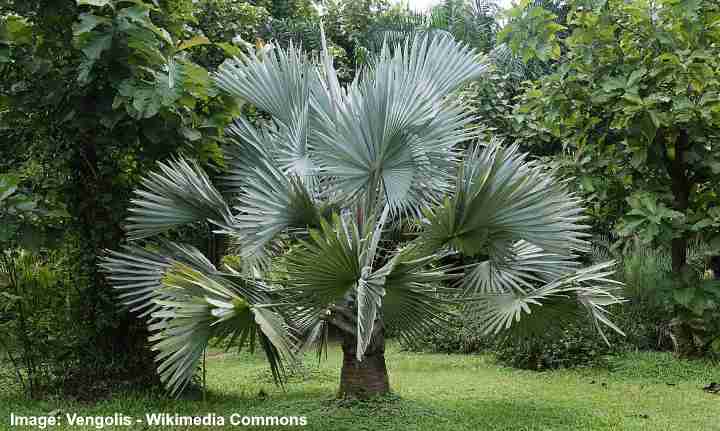
The Bismarck palm tree has beautiful silvery gray foliage and is cold sensitive
The Bismarck palm is not native to Florida, but it’s one of the most sought-after palms in the southern states. The spectacular drought-tolerant tall palm is easily recognizable by its long, fat, fibrous trunk and showy display of huge silvery-gray fronds.
The Bismarck palm tree can reach a height of up to 70 ft. (21 m), while its leaves can span up to 10 ft. (3 m). Its rounded crown can extend over 22 ft. (7 m) in width. Small, creamy flowers are produced during springtime. Fruits are exclusively produced by the female palm, initially appearing yellow-green and later maturing into a brownish-black color.
The Bismarck palm grows best in full sun, though it can tolerate partial shade. Grow the plant in well-drained soil.
This tree requires minimal maintenance, with only the occasional removal of dead fronds.
The cold-sensitive Bismarck palm only grows in the south of Florida in zones 10 to 11.
Florida Palm Tree Identification: The Bismarck palm is identified by its massive silvery crown of palm leaves and a fat, rough trunk.
USDA Zone: 10-11
Sun Exposure: Full sun to partial shade
Plant Size: Up to 70 ft. (21 m)
Florida Silver Palm (Coccothrinax argentata)
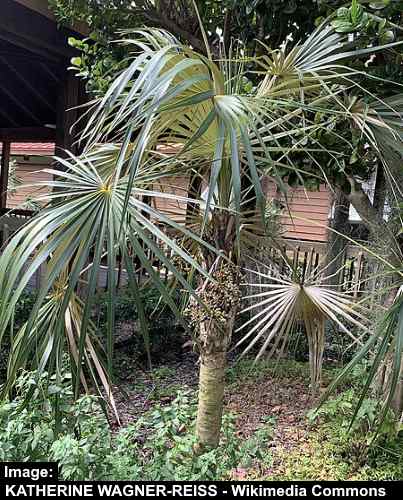
The native Florida silver palm is a type of slow growing palm tree
The Florida silver palm is a small native Florida palm tree, reaching heights between 6.5 and 20 ft. (2 – 6 m). It is characterized by its slender, smooth trunk, dark blue-green leaves with a silver underside, globose purple-black palm fruits, and creamy-white flowers that grow on long stalks.
The Florida silver palm thrives in a wide range of soils, but it requires a well-drained area for planting. This palm tree is resilient to drought, salt, and grows well in both full sun and partial shade.
The Florida silver palm grows in southern Florida in zones 10b through 11.
Florida Palm Tree Identification: The Florida silver palm tree can be identified by its single smooth upward-growing trunk. Additionally, observe the palmate compound silvery-gray leaves, which contribute to the palm crown’s globular appearance.
USDA Zone: 10b-11
Sun Exposure: Full sun to partial shade
Plant Size: 6.5 to 20 ft. (2 to 6 m)
Paurotis Palm (Acoelorrhaphe wrightii)
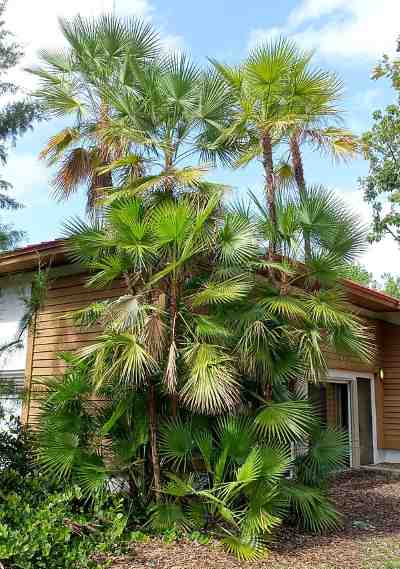
Paurotis palm is a small to medium sized tree with fanning fronds
The Paurotis palm is a small native Florida palm tree, growing between 16 and 23 ft. (5 – 7 m). It is also known as the Everglades palm, Madeira palm, and Cubas palm. It is easily identifiable due to its light green fanning leaves and slender trunk with fibrous growth. With its thin trunk and fanning leaves, the Paurotis palm has a skimpy look. The palm produces small, creamy-white flowers and berries that are initially orange and turn black during maturity.
The Paurotis palm is drought tolerant and adapts well to various soil types, ranging from acidic to alkaline. It thrives in both full sun and partial shade. To preserve the tree’s aesthetic appeal, it is recommended to regularly trim the dead leaves and fruits of the Paurotis palm.
The Paurotis palm tree grows in zones 9 through 11.
Florida Palm Tree Identification: The Paurotis palm is identified by its light green-colored fronds that fan out, giving the slender palm a spiky appearance.
USDA Zone: 9-11
Sun Exposure: Full sun to partial shade
Plant Size: 16 to 23 ft. (5 – 7 m)
Solitaire Palm Tree (Ptychosperma elegans)
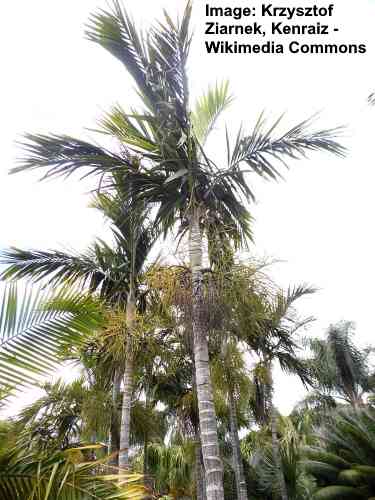
The Solitaire palm is a medium-sized tree suitable for growing in South Florida
The solitaire palm is a small to medium-sized palm tree, ranging from 20 to 40 ft. (6 – 12 m) in height. Also known as the elegant palm, it is popular in Florida’s garden landscapes, thriving in warm tropical conditions. The palm has a smooth, thin stem. Its pinnately compound, dark-green fronds can reach up to 8 ft. (2.4 m) in length and emerge from a long, straight stem. The plant produces greenish-white flowers and small, round fruits that are red in color.
The solitaire palm is self-cleaning and thrives in full or partial sun and well-drained, sandy soil.
The solitaire palm is ideal for growing in zone 11. The palm is hardy to 40°F (4.5°C).
Florida Palm Tree Identification: The solitaire palm tree is identified by a smooth, slender gray stem that bulges at the base. Look for pinnate leaves with an arching growth and clusters of red palm fruits that further aid in identifying the solitaire palm tree.
USDA Zone: 11
Sun Exposure: Full to partial sun
Plant Size: 20 to 40 ft. (6 – 12 m)
Buccaneer Palm (Pseudophoenix sargentii)
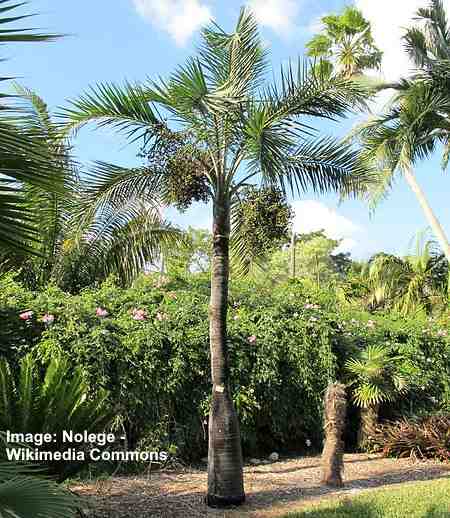
Buccaneer palm is medium sized tree which is slow growing and cold sensitive
The buccaneer palm, also known as the Florida cherry palm, is a medium-sized palm tree native to Florida. It can grow up to 26 ft. (8 m) tall and is identified by its long, arching fronds and smooth trunk with distinct ringed patterns. The branches of this slow-growing, graceful palm spread out in a fan-like pattern. The palm produces yellowish flowers and bright red fruit.
The buccaneer palm is an excellent choice for those seeking a low-maintenance palm tree option. This palm tree thrives in full sun to lightly shaded areas and is classified as drought tolerant, making it suitable for regions with limited water availability. It can also withstand saltwater conditions, making it a great choice for coastal areas or near saltwater sources. It prefers sandy, well-drained soil, though it can adapt to other soil types as well.
The buccaneer palm is characterized by its long, arching fronds that grow in graceful fans. These fronds come in various colors, including silver-gray, blue, and green, adding visual appeal to any landscape. The trunk of the buccaneer palm is smooth with a slightly bulging lower section, featuring distinct ringed patterns that aid in its identification.
As the buccaneer palm matures, it develops a self-cleaning habit. However, while it is younger, occasional pruning of a frond may be necessary.
The buccaneer palm is a cold-sensitive palm that grows well in zones 10a through 11.
If you like the look of buccaneer palm, you can also grow it in a container and move it indoors during the winter.
Florida Palm Tree Identification: The buccaneer palm is identified by its slightly bulging trunk with ring markings, and long branches that can reach up to 10 ft. (3 m) in length. These branches arch out, creating a wide canopy.
Related: Indoor Palm Plants: Types and Care
USDA Zone: 10a-11
Sun Exposure: Full sun to light shade
Plant Size: Up to 26 ft. (8 m)
Foxtail Palm (Wodyetia bifurcata)
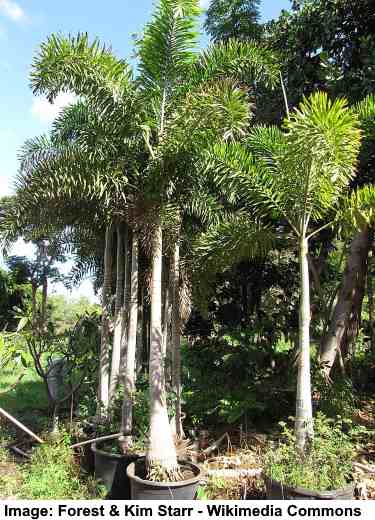
Foxtail palm is a medium sized tree suitable to growing in south Florida
The foxtail palm is a medium-sized palm that grows up to 30 ft. tall (9 m) and is a popular species in Florida. It is identified by its arching dark green fronds that grow from the top of the silvery-white trunk. The palm produces medium-sized, round fruits that transition from green when unripe to orange-red when fully ripe. Additionally, it grows creamy white flowers that emerge from stalks at the base of the crownshaft.
The foxtail palm earns its name from its bushy, arching fronds, which resemble a fox’s tail. Similar to the massive royal palm, the foxtail palm is a fast-growing palm tree.
This palm tree is drought-tolerant and thrives in well-drained soil. It can tolerate partial shade but grows best in full sunlight. In addition, it is self-cleaning, so very little maintenance is needed when growing this tree.
The foxtail palm grows in zones 10b and 11, and it is a popular palm in Florida. However, it will only thrive in the southern areas of the state.
Florida Palm Tree Identification: The foxtail palm can be recognized by its bushy, arching fronds and its smooth, columnar trunk devoid of branches. The trunk often displays white ringed patterns.
USDA Zone: 10b-11
Sun Exposure: Full sun to partial shade
Plant Size: Up to 30 ft. tall (9 m)
Queen Palm (Syagrus romanzoffiana)
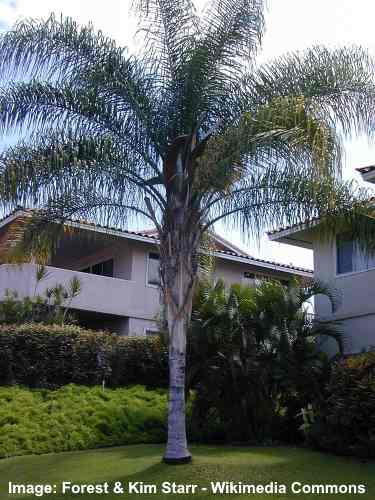
The Queen palm is a popular ornamental fast growing tree
The queen palm is a fast-growing, medium-sized palm tree native to Florida, reaching heights of up to 50 ft. (15 m). Its long, pinnate dark green leaves consist of numerous leaflets measuring approximately 1.5 ft. (50 cm) in length, creating a dense, bushy crown. During the summertime, it produces plumes of creamy-white flowers.
This queen palm has a single, smooth trunk, glossy bright green leaves, a drooping canopy, and golden orange palm dates.
For optimal growth, plant the queen palm in an area with full sun or light shade. It is an easy-to-grow, hardy tree with resistance to both drought and light frost. The queen palm thrives best in acidic soils and benefits from being fertilized twice a year with a manganese-rich fertilizer.
The queen palm is an ideal plant for ornamental gardens in Florida, specifically in zones 9 through 11.
Florida Palm Tree Identification: When identifying Florida palm trees, the queen palm can be recognized by its single, smooth trunk, glossy bright green leaves, drooping canopy, and golden orange palm dates.
USDA Zone: 9-11
Sun Exposure: Full sun to light shade
Plant Size: Up to 50 ft. (15 m)
Chinese Fan Palm (Livistona chinensis)
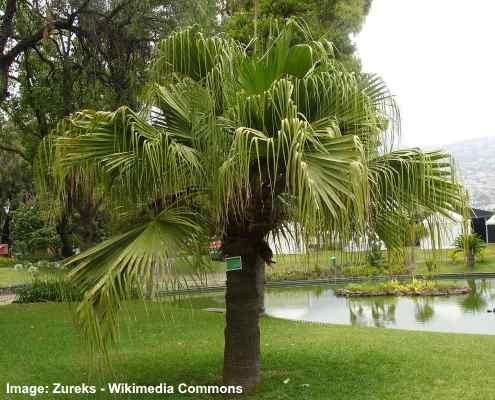
The Chinese fan palm is a cold hardy decorative tree
The Chinese fan palm is a tall, beautiful palm tree that can reach up to 50 ft. (15 m) in height. It is an ideal tree for ornamental gardens in Florida. These hardy palms thrive in all parts of Florida. They are characterized by drooping green fan leaves that create a distinctive fountain-like appearance.
The Chinese fan palm also has a tall, straight trunk and spreading crown. The palm produces abundant yellow flowers that bloom during spring and summer, fruits that initially have a yellow color and gradually transform into a vibrant red as they mature.
Chinese fan palms demonstrate excellent tolerance to various soil types, provided that the soil is well-drained. They also have a moderate resistance to saltwater and can grow well in extended periods of drought. In addition, they perform well in full sun to partial shade.
Chinese fan palms don’t require much maintenance aside from occasional pruning to ensure they keep a healthy appearance.
Chinese fan palms are cold hardy to 20°F (-12°C) and are suitable for zones 9 through 11.
Florida Palm Tree Identification: Identify the Chinese fan palm by its fan-shaped leaves with an arching growth habit that creates a bushy, drooping crown.
USDA Zone: 9-11
Sun Exposure: Full sun to partial shade
Plant Size: Up to 50 ft. (15 m)
Canary Island Date Palm (Phoenix canariensis)
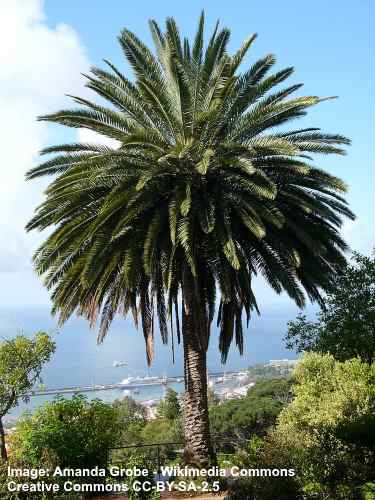
Canary Island date palm is a tall and cold hardy tree
The Canary Island date palm is a popular palm tree that thrives in sunny environments along the south coast. It can grow to a towering height of up to 66 ft. (20 m), making it generally too tall for most residential garden landscapes in Florida. Creamy-yellow flowers emerge in hanging clusters from the palm.
This robust palm tree has a rough, straight trunk with a bronze-colored appearance and a prominent bulge at its crownshaft. The arching green leaves, arranged in a pinnate pattern, grow from a central point at the top of the elongated trunk.
The Canary Island date palm is well-suited for full sun exposure and requires well-drained soil, but it can also tolerate drought, salt, and flood conditions. Regular pruning of dead fronds is necessary to maintain its healthy appearance.
The Canary Island date palm is suitable for growing in zones 8a through 11. Canary Island date palms can withstand temperatures as low as 15°F (-9°C) for short periods without sustaining significant damage.
Florida Palm Tree Identification: The Canary Island date palm is identified by its tall upright trunk, with a crown of stiff, sharp leaves, and clusters of palm fruits—bunches of orange-yellow dates.
USDA Zone: 8a-11
Sun Exposure: Full sun
Plant Size: Up to 66 ft. (20 m)
Ribbon Fan Palm (Livistona decipiens)
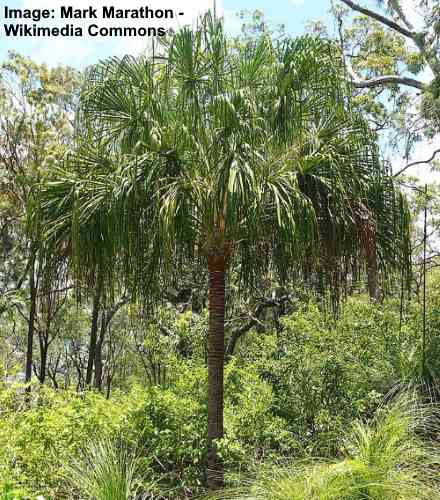
The ribbon fan palm is slow growing and commonly found in south and central Florida
The ribbon fan palm is native to Australia but has gained popularity in the southern and central regions of Florida. It is a slow-growing palm that can eventually reach a height of 60 ft. (18 m). The palm produces clusters of fragrant yellow blooms and small, black fruits.
The ribbon fan palm tree is characterized by its single, upright, and straight trunk with a smooth texture. It derives its name from the fan-shaped leaves that elegantly split into long, drooping ribbons.
This tree thrives best when grown outdoors in full sun and well-drained soil. Once established, it is drought-tolerant, although it prefers regular watering.
The ribbon fan plant is suitable for growing in USDA zones 9 through 11 in Florida.
Florida Palm Tree Identification: The ribbon fan palm can be identified by its graceful, ribbon-like fronds that form an umbrella-shaped, bushy palm crown.
USDA Zone: 9-11
Sun Exposure: Full sun
Plant Size: Up to 60 ft. (18 m)
Cabbage Palm (Sabal palmetto)
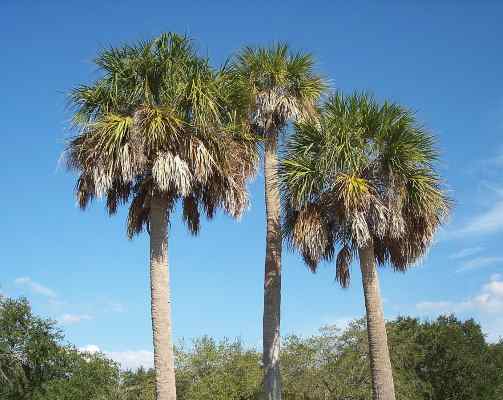
Cabbage palm is a tall cold hardy tree native to Florida
The cabbage palm (Sabal palmetto) is a tall palm tree native to Florida and holds the distinction of being the state tree. Growing up to 65 ft. (20 m) in height, the cabbage palm features a fibrous trunk with a combination of bronze and gray colors. It has fan-shaped leaves and a rounded crown situated atop a long, single trunk. One of the distinguishing characteristics of this Florida palm is the presence of brown-colored, dead palm leaves hanging at the base of the crown.
In late spring, this palm tree adorns itself with abundant clusters of petite, white flowers. As the season progresses, it produces distinctive purple-black fruits that ripen in late summer
The cabbage palm is flood-tolerant, salt-tolerant, and thrives in poorly drained soil, making it a good palm tree for planting in wet environments. It is also drought-tolerant once established and prefers full-sun.
To maintain an attractive appearance, it is recommended to prune the brown leaves.
The cabbage palm grows in zones 8 through 11 and can survive winter temperatures as low as 9°F (-12°C).
Florida Palm Tree Identification: Identify Florida’s state palm by its smooth, gray trunk at the base, transitioning to a bronze and rough texture due to the presence of old leaf petioles.
USDA Zone: 8-11
Sun Exposure: Full sun
Plant Size: Up to 65 ft. (20 m)
Florida Royal Palm (Roystonea regia)
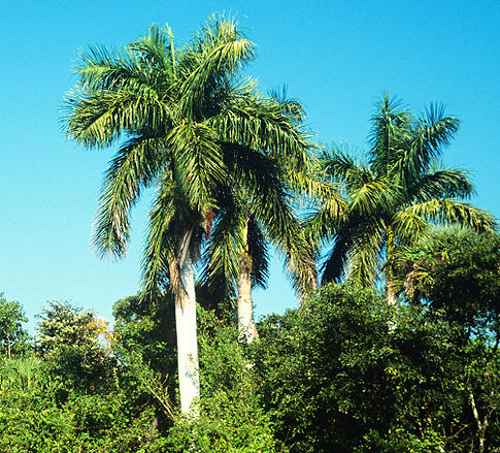
The tall Florida royal palm can reach up to 66–98 ft. (20–30 m)
The Florida royal palm is a tall palm tree native to Florida, reaching heights of up to 70 ft. (21 m). It is one of the tallest palm tree species found in South Florida. The dark-green, pinnate palm leaves can grow up to 13 ft. (4 m) in length. The palm tree produces round fruits that are initially green and become purplish-black when mature. The tree also produces beautiful hanging clusters of small, fragrant white flowers.
The Florida royal palm tree is commonly seen along roadsides and in parks. It is characterized by its thick, bulging, and smooth trunk with a whitish-gray color. Another distinctive feature is the smooth green crown-shaft located at the top of the tree.
Florida royal palm trees are self-cleaning, naturally shedding approximately one leaf per month. When planting this tree near residential areas, it’s important to consider the potential hazard posed by the large, fan-shaped leaves. These leaves can grow up to 15 feet (4.5 m) in length and weigh as much as 50 pounds (22.6 kg), potentially posing a risk to people and property when they fall.
Florida royal palm grows best in full sun but is tolerant of partial shade. In addition, this tree thrives in moist, well-drained soil and can withstand drought once established.
These regal-looking palms thrive in zones 10a through 11 and are cold hardy down to 26°F (-3°C) when they are well established.
Florida Palm Tree Identification: To identify the Florida royal palm, look for the green crown-shaft near the arching leaves. Additionally, the trunk is thick, robust, tall, and straight, displaying a grayish color with visible rings.
USDA Zone: 10a-11
Sun Exposure: Full sun to partial shade
Plant Size: 70 ft. (21 m)
Coconut Palm (Cocos nucifera)
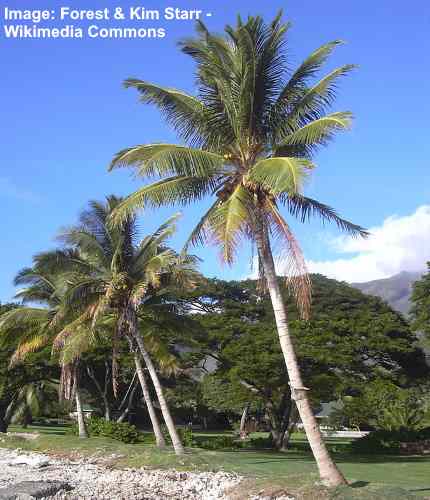
Coconut palms are popular trees in south Florida and thrive in warm tropical conditions
Coconut palms are a popular species of palm tree in Florida, known for their long, curving, and smooth trunks that can grow up to 100 ft. (30 m) tall. They are characterized by their deep-green, pinnate leaves that grow at the very top of the tree, creating an arching crown. Coconut palms bloom all year round and produce small, light-yellow flowers that grow on large stalks.
One of the distinctive features of palms in the genus Cocos is their fruit, coconuts, instead of juicy dates. It takes approximately six years for the tree to begin fruiting, and it reaches full production after 15 years, yielding between 50-200 coconuts per year.
Coconut palms have a broad tolerance for various soil types, provided they are well-drained. They display moderate resilience to drought, flooding, and saltwater. These palms flourish when exposed to full sunlight.
To ensure your coconut palm is healthy and retains its beauty, it is advisable to periodically trim any dead or drooping leaves.
These cold-sensitive coconut palms thrive better in the southern part of Florida, specifically in zones 10a and 10b.
Florida Palm Tree Identification: Coconut palms can be identified by their smooth gray trunks, which often have a large bulge at the base. The pinnate leaves of coconut palms can grow up to 20 ft. (6 m) in length.
USDA Zone: 10a-10b
Sun Exposure: Full sun
Plant Size: Up to 100 ft. (30 m)
King Palm / Bangalow Palm (Archontophoenix cunninghamiana)
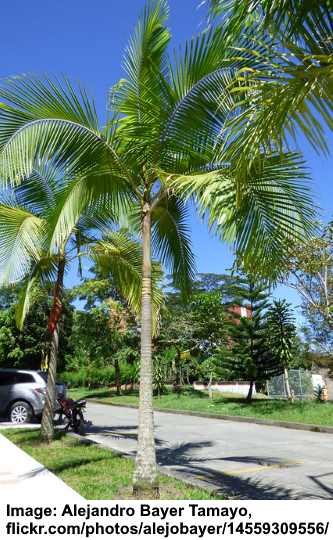
King palm is a tall tree with a slender trunk that grows well in Florida
The king palm tree, also called the Bangalow palm, is a popular palm that thrives in Florida’s humid subtropical climate. It grows around 65 ft. (20 m) tall and 10 to 15 ft. (3 – 4.5 m) wide. The crown consists of 15 to 20 palm fronds measuring up to 15 ft. (4.5 m) long, with around 100 to 150 leaflets on each stem. This fast-growing palm tree has a single, erect, brownish-gray trunk, arching, evergreen fronds, and an attractive crown. The palm produces dark purple flowers during the spring and summer.
The king palm is identified by its masses of round red fruits that grow in long, dangling clusters.
The king palm can thrive in a range of soils, requiring average water needs and full sun. The coconut palm is low-maintenance as it is self-cleaning, so pruning is not needed.
The USDA zone for the king palm in Florida is 10a.
Florida palm tree identification: The king palm has an identifiable straight, slender grayish trunk that is slightly wider at the base. Arching green fronds create a spray of foliage at the crown-shaft.
USDA Zone: 10a
Sun Exposure: Full sun
Plant Size: Up to 65 ft. (20 m)
Red Latan Palm Tree (Latania lontaroides)
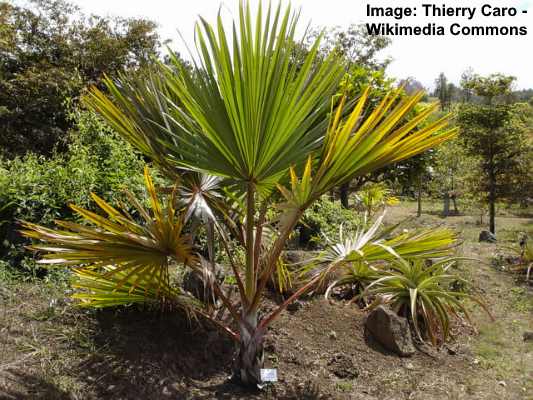
Red latan palm grows in southern Florida and is a medium sized slow growing palm tree
The red latan palm is a slow-growing tropical palm that thrives in Florida’s southern coastal regions. It prefers full sun and moist, well-drained soil. The large palm reaches 30 to 40 ft. (9 – 12 m) tall with a rounded crown measuring up to 20 ft. (6 m) wide. Each frond is 8 ft. (2.4 m) wide and consists of stiff leaflets growing on 5 ft. (1.5 m) stems. The palm has a smooth, gray, woody trunk with a slightly swollen base.
The red latan palm has identifiable ridged, fan-shaped light green fronds with a whitish sheen. The upward-growing fronds create a large, rounded crown with a spiky appearance. In spring, small yellow flowers bloom, followed by brownish-green palm fruits.
The common name ‘red latan’ comes from the reddish frond stems and leaflets that grow on immature red latan palm trees.
Due to its impressive tolerance to both drought and salt, the palm is an excellent option for home gardens in coastal or dry areas. Prune any dead or damaged fronds to maintain its attractive appearance.
Red latan palm trees thrive in USDA zones 10 through 12.
Florida palm tree identification: The red latan palm is easy to recognize in Florida. Its distinctive red-tinged leaves turn green and have a silky, silvery appearance.
USDA Zone: 10-12
Sun Exposure: Full sun
Plant Size: 30 to 40 ft. (9 – 12 m)
Fishtail Palm (Caryota mitis)
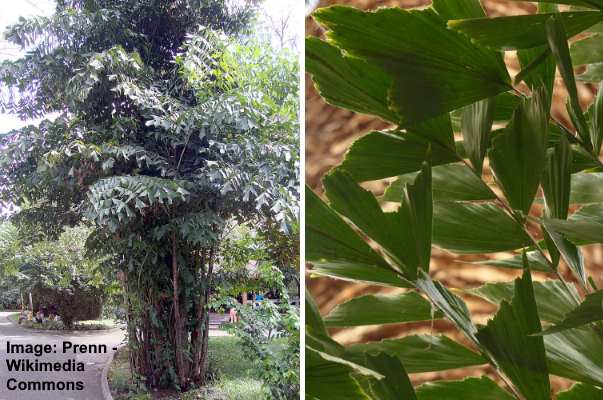
Fishtail palm is a multi-stemmed tree with distinctive leaves
The fishtail palm is a medium-sized tree identified by its unusual, deep green bipinnate leaves resembling a fish’s tail fin. It grows as a multi-stemmed palm, reaching up to 40 ft. (12 m) in height with a spread of 10 ft. (3 m) wide. The fishtail palm has long leaves measuring 10 ft. (3 m) in length.
In spring, the clustering fishtail palm produces attractive creamy-white flowers that complement its glossy feathery green fronds. After blooming, the flowers give way to dark red to purplish poisonous fruits.
The fishtail palm grows best in moist, well-drained soil and full, direct sunlight.
The palm tree is easy to maintain, only needing occasional pruning of dead or damaged leaves.
The fishtail palm thrives in USDA zones 9b to 11 in Florida.
Florida palm tree identification: The fishtail palm is easily identified by its ruffled fronds. Each shiny green leaflet has a triangular shape with serrated margins resembling the tail of a fish
USDA Zone: 9b-11
Sun Exposure: Full sun
Plant Size: Up to 40 ft. (12 m)
Montgomery Palm (Veitchia arecina)

Montgomery palm is an attractive tall Florida palm tree with a slim trunk and beautiful crown
The Montgomery palm is a tall and slender palm tree that can grow up to 80 ft. (24 m) in height, and is a common sight in Florida’s landscapes. The palm tree has a straight and erect grayish smooth, slim trunk with a crown of long, serrated, pinnate fronds measuring up to 10 ft. (3 m). The arching fronds emerge from a whitish crown-shaft.
Montgomery palm trees are considered one of the top ten palms in Florida. In spring, these solitary palms bloom with clusters of greenish-white flowers on 3 ft. (1 m) long stems. After blooming, the palm tree produces clusters of red palm fruits measuring 1 to 2 inches (2.5 – 5 cm) in length.
The Montgomery palm can tolerate temperatures as low as 30°F (-1°C) once established, and prefers sunny locations with moist, well-drained soil. It is drought-tolerant once established.
Montgomery palms grow in USDA zones 10a to 11 in Florida.
Florida palm tree identification: The Montgomery palm is easily recognizable in Florida due to its slender and grayish long trunk, beautiful crown of arching pinnate fronds, pale green crown-shaft, and red fruits.
USDA Zone: 10a-11
Sun Exposure: Full sun
Plant Size: Up to 80 ft. (24 m)
Red Sealing Wax Palm / Lipstick Palm (Cyrtostachys renda)
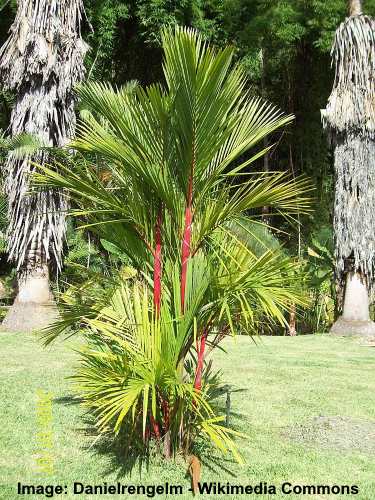
Red sealing wax palm is a small tree with distinctive red stems that adds color to Florida gardens
The red sealing wax palm is an eye-catching addition to Florida landscapes, known for its vibrant red crown-shafts. Also known as the lipstick palm, this tropical beauty features smooth red stems and dark green palmate leaves with stiff upward-growing leaflets. In gardens, lipstick palms typically reach a height of 10 to 20 ft. (3 – 6 m).
Red sealing wax palms are multi-stemmed trees with slender trunks. The stems start off red and gradually turn green as the palm tree grows, while the striking red crown-shaft remains at the top. The lipstick palm produces small greenish flower stalks before developing inedible oval black fruits.
The red sealing wax palm requires minimal maintenance, with pruning limited to removing dead or damaged fronds.
The red sealing wax palm thrives in USDA Zone 11 in Florida, preferring full sun and consistently moist soil.
Florida palm tree identification: The red sealing wax palm is easily recognized by its multiple stems and unmistakable scarlet-colored crown-shaft, which sets it apart. The upward-growing, stiff, and slender leaflets create an irregular and spiky crown.
USDA Zone: 11
Sun Exposure: Full sun
Plant Size: 10 to 20 ft. (3 – 6 m)
Arikury Palm (Syagrus schizophylla)

Arikury palm is a dwarf tree suitable for small gardens in Florida
The arikury palm is a perfect small accent palm, ideal for compact Florida landscapes. The super-long, dark-green palmate fronds extend directly from the ground and clump together into a tree-like plant. The long fronds measure 4 to 6 ft. (1.2 – 1.8 m) long and have an arching and drooping habit.
The attractive arikury palm grows up to 6 ft. (1.8 m) high with a spread of 10 ft. (3 m). The identifying feature of this Florida palm is its distinctive toothed petioles. Unlike other ornamental palms in Florida, the arikury palm lacks a smooth crown-shaft.
Other characteristics of the arikury palm are 2 to 3 ft. (0.6 – 1 m) flowering stems with golden yellow flowers, yellow or orange fruits measuring 1 inch (2.5 cm) long, and a shaggy-looking trunk.
The arikury palm excels in dry conditions, displays moderate salt tolerance, and flourishes in sandy, well-drained soil. It thrives in full sun to partial shade and requires little maintenance, rarely needing any pruning.
The arikury palm is suitable for growing in USDA zones 10-11.
Florida palm tree identification: The arikury palm is easy to identify in the landscape due to its low height, short trunk, and long arching dark green palmate fronds.
USDA Zone: 10-11
Sun Exposure: Full sun to partial shade
Plant Size: Up to 6 ft. (1.8 m)
European Fan Palm / Mediterranean Fan Palm (Chamaerops humilis)

The Mediterranean dwarf palm has few trunks and is small enough to suit many gardens in Florida
Also known as the Mediterranean fan palm, the European palm is a small multi-stemmed palm tree that typically reaches a height of 10 to 20 ft. (3 – 6 m). This compact palm features thick, spiny trunks and fan-shaped silvery-green stiff leaves that can grow up to 5 ft. (1.5 m) in length. During spring, it produces clusters of fragrant, small yellow flowers, followed by green fruits that turn brown when ripe.
The hardy and multi-stemmed Mediterranean fan palm is a popular choice for gardens in Florida. Its slow growth makes it ideal for creating attractive focal points or corner accents in small garden landscapes. The palm’s robust stems with jagged spines, fan-shaped palmate evergreen leaves, and compact form add to its appeal.
It thrives in full sun but can tolerate partial shade. The palm is drought-tolerant once established. For optimal growth, it prefers moist, well-drained soil conditions.
The Mediterranean fan palm thrives in USDA zones 8a to 11 in Florida.
Florida palm tree identification: The European fan palm can be identified by its blue-green or silvery green rounded fan-shaped fronds, clumping thick stems adorned with jagged spines, and sharp needle-like spines on the petioles.
USDA Zone: 8a-11
Sun Exposure: Full sun to partial shade
Plant Size: 10 to 20 ft. (3 – 6 m)
Pygmy Date Palm (Phoenix roebelenii)
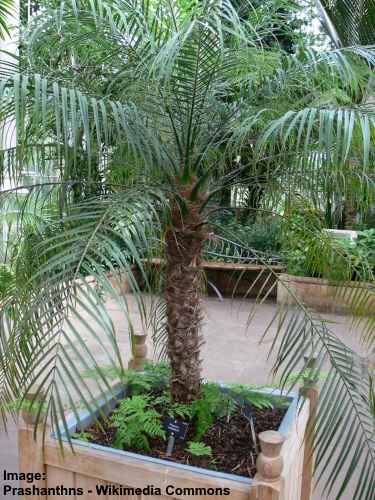
The pygmy date palm is a small palm tree with spiky trunk that is commonly used in Florida landscaping
The pygmy date palm is a small palm tree that can reach a height of 6 to 12 ft. (1.8 to 3.6 m). It is known for its single shaggy trunk, a gracefully rounded arching crown of drooping fronds, and black oval palm fruits. The bright green palmate leaves grow up to 4 ft. (1.2 m) long and have sharp spines at the petiole’s base. Creamy-white flowers and black fruits grow on 1 ft. (30 cm) long stems.
The pygmy date palm is widely used in landscaping throughout Florida. Typically, three to five of these single-trunk palm trees are planted together to enhance the garden landscape. Not only does the pygmy date palm make a stunning focal point in a landscape, but it also adds beauty to container gardens.
The pygmy date palm prefers moist, well-drained soil. It is drought-tolerant once established and grows well in bright, indirect sunlight to partial shade.
The palm is not self-cleaning, so you may need to occasionally remove dead or dying leaves.
Pygmy date palms thrive in USDA zones 9a to 11 in Florida.
Florida palm tree identification: The pygmy date palm looks like a miniature Florida palm tree with a stumpy, short trunk. The palm has a distinctive bushy crown made of feathery palmate leaves over 3 ft. (1 m) long.
USDA Zone: 9a-11
Sun Exposure: Indirect sunlight to partial shade
Plant Size: 6 to 12 ft. (1.8 to 3.6 m)
African Oil Palm (Elaeis guineensis)
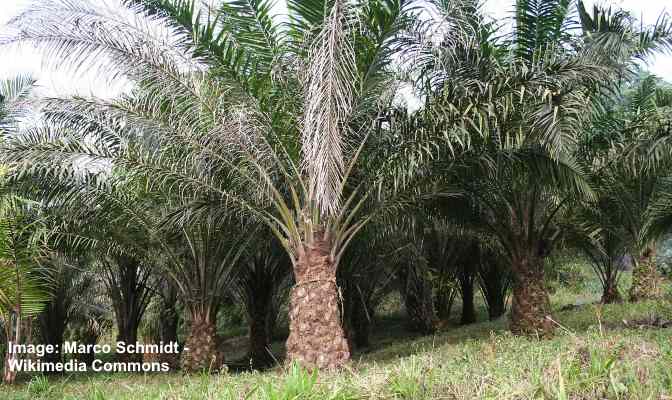
Oil palm fruits are commonly used in oil production
The African oil palm is a single-stemmed palm with a slender greenish-brown upright trunk, huge pinnately compound dark-green leaves, and large clusters of red, oily plum-sized fruits. In the landscape, an African oil palm grows over 66 ft. (20 m) tall and has a broad, spreading crown consisting of arching palmate leaves 16 ft. (5 m) long.
African oil palms are principally grown for their palm oil and are one of the world’s most oil-producing plants. The orangey-red palm fruits grow in bunches weighing between 11 and 66 lbs. (5 – 30 kg).
In addition to the red palm fruits, other recognizable features of the African oil palm are its vase shape, clusters of pale-yellow flowers, and knobby trunk.
The palm is adaptable to various soil types, including light, medium, and heavy soils. It can thrive in soils with a range of pH levels, including mildly acidic, neutral, basic (mildly alkaline), and even very acidic soils. It grows best in full sun.
The African oil palm thrives in USDA zones 10b to 11 in Florida.
Florida palm tree identification: The African oil palm is identified by its grayish trunk covered in triangular woody ridges. The beautiful shape of the palm tree is due to its upward arching pinnate fronds and colorful fruits dangling in large clusters.
USDA Zone: 10b-11
Sun Exposure: Full sun
Plant Size: Up to 66 ft. (20 m)
Parlor Palms (Chamaedorea elegans)
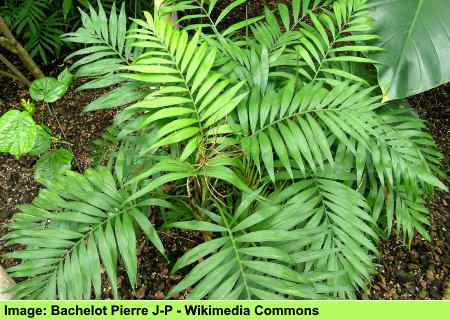
The Parlor palm is a small low maintenance tropical palm tree. It is also considered to be one of the lucky plants according to the Feng Shui
The parlor palm is a small shrub-like palm tree that forms clumping cane-like stems emerging from the ground. It is identified by dark green pinnate leaves measuring 18 to 24 inches (45 – 60 cm), with slender lance-shaped leaflets growing alternately. The palm also produces golden yellow flowers and small, fleshy black fruits.
In a subtropical garden landscape, the leafy palm shrub typically reaches a height of around 7 ft. (2.1 m). During early spring, small ball-shaped golden yellow flowers appear, followed by dark palm fruits.
Parlor palms are also popular as indoor plants and thrive in typical indoor conditions. They are easy to grow and their arching evergreen fronds can add natural color to any indoor space. Moreover, they have the added advantage of helping to purify household air.
The parlor palm thrives in bright, indirect sunlight and can tolerate partial shade. It is drought-tolerant and will grow well in any well-drained soil type.
Pruning should be avoided for this palm, except when necessary to remove dead foliage.
The parlor palm thrives in USDA zones 10 to 12.
Florida palm tree identification: The parlor palm is a tropical plant with slender green stems, a bushy, rounded crown, and crescent-shaped compound palmate leaves.
USDA Zone: 10-12
Sun Exposure: Indirect sunlight to partial shade
Plant Size: Up to 7 ft. (2.1 m)
Lady Palm (Rhapis excelsa)

The lady palm is a multi stem tree that you can grow at home
The lady palm is a spreading shrub-like palm tree with a clustering habit. The large, palmately dissected, glossy dark green leaves are fan-shaped with three to ten leaflets on a leaf. The bushy palm plant grows between 6 and 15 ft. (1.8 – 4.5 m) and forms a rounded leafy mound in a landscape. It produces plump, white fruits, as well as tiny, fragrant yellow flowers.
Rhapis excela is also called the clustered finger lady leaf palm. This common name is due to the finger-like, narrow leaflets that droop gracefully from long, erect, reed-like stems. This palm is also called the bamboo palm because of its woody, straight stems.
The advantage of growing a lady palm is that it’s incredibly tolerant of deep shade and is resistant to drought.
You can also grow a lady palm as a container plant to add greenery to shaded rooms where other plants would struggle due to a lack of sunlight. Grow this palm in loamy, well-drained soil.
Pruning of the lady palm primarily involves removing damaged or dead fronds and regularly eliminating the suckers to maintain the plant’s growth and appearance.
The lady palm is cold-hardy in USDA zones 9 through 11 and is used as an outdoor landscaping plant throughout Florida.
Florida palm tree identification: The lady palm is identified by several slender grayish trunks covered in light brown fiber. This medium-sized palm has fan-shaped dark green leaves divided into slender, pointed fingers.
- Find out many other indoor palm plants and how to care for them.
- Discover the most amazing small or dwarf palm trees.
USDA Zone: 9-11
Sun Exposure: Partial sun to full shade
Plant Size: 6 and 15 ft. (1.8 – 4.5 m)
Golden Cane Palm (Dypsis lutescens)
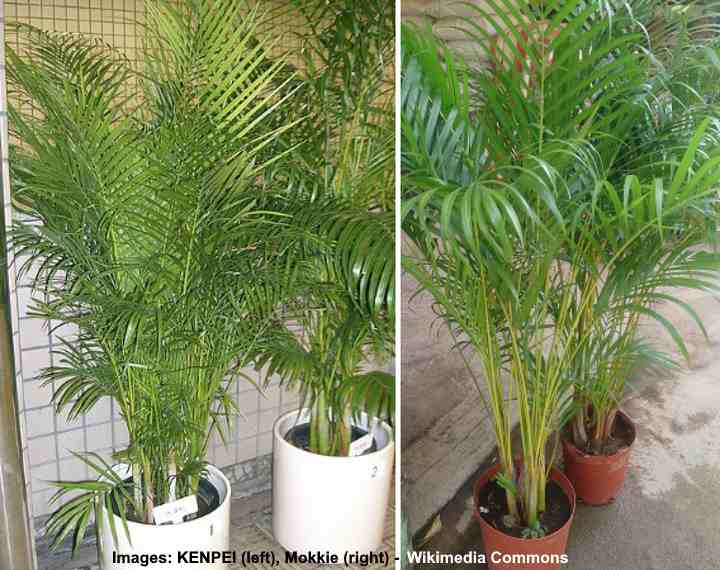
The golden cane palm (also known as areca palm) can be grown indoors and will give a tropical look to any space
The golden cane palm is a multi-stemmed palm tree that thrives in Florida landscapes. It is characterized by airy fronds with yellowish-green to dark-green lance-shaped leaflets that grow in a V shape on the arching stems. The golden cane palm bears resemblance to the popular lady palm tree in many aspects.
This attractive plant is also known as the bamboo palm, areca palm, yellow palm, or butterfly palm. The term ‘butterfly palm’ refers to the unique shape of the fronds, which curve upward like butterfly wings.
Growing between 20 and 35 ft. (6 – 10 m) tall, the golden cane palm forms a spreading crown that measures 10 to 20 ft. (3 – 6 m) wide. Other identifying features of this multi-cane palm tree include yellow or green rings around the stems, yellow flower stalks, and egg-shaped fruits measuring 1 inch (2.5 cm) in length.
The golden cane palm thrives in moist, well-drained soil and exhibits excellent drought tolerance once established. It can be grown in areas with full sun to partial shade. Pruning needs are minimal, typically limited to the removal of yellow or withered leaves.
The golden cane palm thrives in USDA zones 10 – 11 in Florida.
Florida Palm Tree Identification: The golden cane palm is recognized by its V-shaped arching fronds adorned with slender lanceolate leaves, which grow on clusters of stems.
USDA Zone: 10-11
Sun Exposure: Full sun to partial shade
Plant Size: 20 to 35 ft. (6 – 10 m)
Christmas Palm (Adonidia merrillii)

The Christmas palm tree is a popular choice in many gardens
The Christmas palm is a beautiful palm tree in Florida that is well-suited for small, compact gardens. It grows to a height of 20 to 25 ft. (6 – 7.6 m) and can spread up to 8 ft. (2.4 m) wide. This fast-growing palm has a slender gray trunk, stiff and arching green leaves, and clusters of small cream-colored blossoms. It has a compact structure with a single stem and an arching crown of palmate leaves. During the summer, the palm produces fragrant creamy-white flowers that emerge from green buds. The palm’s name comes from its production of bright red, oval fruits.
Once established in the landscape, the Christmas palm thrives in full sun and has tolerance to drought, poor soils, and salty air. It grows best in moderately sandy, well-drained soil.
The Christmas palm doesn’t require much maintenance, apart from removing dead or damaged fronds.
The Christmas palm is suitable for USDA zones 10a – 11 in Florida.
Florida Palm Tree Identification: The Christmas palm can be identified by its smooth gray stem, prominent green crown shaft, and strongly arching fronds that can grow up to 5 ft. (1.5 m) in length.
USDA Zone: 10a-11
Sun Exposure: Full sun
Plant Size: 20 to 25 ft. (6 – 7.6 m)
Alexandra palm (Archontophoenix alexandrae)
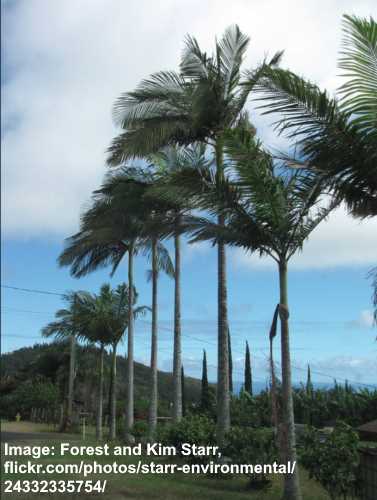
Alexandra palm is a tall tree with a slender trunk suitable for tropical Florida landscapes
The Alexandra palm is a beautiful Florida palm tree with an erect gray trunk topped by huge feather-like, dark-green fronds. The solitary palm tree grows up to 100 ft. (30 m) tall with a trunk 1 ft. (0.3 m) in diameter. The large pinnate fronds are 15 ft. (4.5 m) long, each containing 60 to 80 leaflets. The tree sporadically blooms with cream-colored flowers and bears fruits that transform from green to red when ripe.
Perfect for tropical landscaping, the Alexandra palm thrives in USDA zones 10 to 12. It also goes by the names feather palm, king palm, and Northern Bangalow Palm.
The Alexandra palm flourishes in well-drained, acidic soil and thrives under full sun exposure. Prune the palm tree to remove dead or damaged fronds.
Florida Palm Tree Identification: The Alexandra palm is identified by its tall, slender trunk, a large crown of arching fronds, green crown-shaft, white flower clusters, and huge bunches of pea-sized red palm fruits.
USDA Zone: 10-12
Sun Exposure: Full sun
Plant Size: Up to 100 ft. (30 m)
Mexican Fan Palm (Washingtonia robusta)
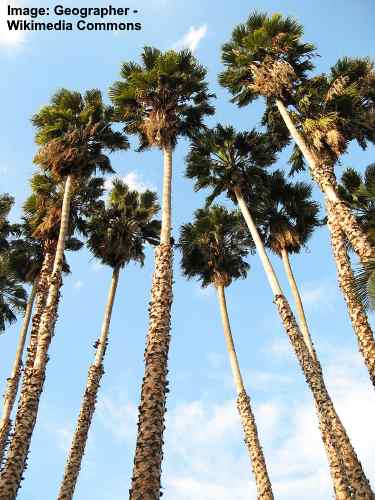
The Mexican palm tree is identified by its tall and skinny trunk and a rounded crown
The Mexican fan palm is a fast-growing palm suitable for growing in Florida. This elegant, slender palm tree features a small rounded crown of rich green palmate leaves sitting on a tall columnar trunk. The popular Florida palms grow 40 to 80 ft. (12 – 24 m) tall.
An unusual feature of the Mexican fan palm is that its dead leaves do not fall off. Instead, they fold down along the trunk, creating a dense skirt. However, the top half of a taller Mexican fan trunk is smooth rather than rough, like the base section caused by leaf scars.
Other features of the Mexican fan palm are its clusters of small white flowers dangling on stems up to 10 ft. (3 m) long. After flowering, bunches of tiny black palm fruits appear.
Being one of the most popular palm trees in the world, Mexican fan palms thrive in full sun and sandy or loamy, well-drained soil. They are highly salt-tolerant, making them well-suited for coastal environments.
To maintain its attractive appearance, occasional pruning throughout the year may be needed.
This beautiful palm flourishes in USDA zones 9 through 11.
Florida Palm Tree Identification: The characteristic features of the Mexican fan palm are its crown of huge rich green palmate fronds growing on an erect, slender stem, and the shaggy appearance of the trunk’s lower section.
USDA Zone: 9-11
Sun Exposure: Full sun
Plant Size: 40 to 80 ft. (12 – 24 m)
Proctor’s Silver Palm (Coccothrinax proctorii)

Proctor’s silver palm has a skinny trunk and fan shaped leaves and is slow growing tree
Also called the Cayman thatch palm, the Proctor’s silver palm is a medium-sized tropical tree with a pencil-like gray trunk. This slender stem is topped by silvery-gray fan-shaped, drooping leaves growing in an open or triangular crown. This attractive tropical palm grows 10 to 20 ft. (3 – 6 m) tall.
This small palm tree is ideal for compact landscapes in Florida. Its tolerance for coastal air, direct sunlight, and poor soil makes it easy to grow in warm climates.
The Cayman thatch palm thrives in moist, well-drained soil, full sun, and has excellent salt tolerance.
This palm flourishes in USDA zones 10 to 11.
Florida Palm Tree Identification: Identifying features of the Cayman thatch palm are its fan-shaped fronds consisting of dark green leaflets above and silvery below.
USDA Zone: 10-11
Sun Exposure: Full sun
Plant Size: 10 to 20 ft. (3 – 6 m)
Caribbean royal palm (Roystonea oleracea)

The Caribbean royal palm is a tall and beautiful tree
The Caribbean royal palm is described as a stately, imposing palm tree due to its tall, erect, cylindrical trunk. This single-stemmed evergreen palm grows up to 130 ft. (40 m) tall. Its large, dark-green, feather-like fronds grow 10 to 16 ft. (3 – 5 m) long, creating a large crown.
The Caribbean royal palm has a whitish-gray trunk with noticeable rings around it. Large panicles of white flowers bloom just under the green crown-shaft. These are followed by blue-violet egg-shaped edible fruits.
This tropical palm tree also goes by the names cabbage palm and imperial palm. Not as cold-hardy as other Florida palms, as it only grows south of Lake Okeechobee. Grow in full sun to partial shade.
This palm grows best in USDA zones 10 to 11.
Florida Palm Tree Identification: The Caribbean royal palm is easily identifiable due to its tall, erect, cylinder-shaped gray trunk, large pinnate leaves, green crown-shaft, and blackish-blue edible fruit.
USDA Zone: 10-11
Sun Exposure: Full sun to partial shade
Plant Size: Up to 130 ft. (40 m)
Yellow Latan Palm (Latania verschaffeltii)

The yellow latan palm tree has huge leaves and is slow growing
The yellow Latan palm tree is a slow-growing exotic tree characterized by its huge fan-shaped, glossy green leaves growing on thick yellow leaf stems. Resembling foliage of the popular Bismarck palm, the large palmate leaves measure 6.5 to 10 ft. (2 – 3 m) wide. These form an open crown on a medium-sized gray trunk.
Yellow latan palm trees grow 36 to 50 ft. (11 – 15 m) tall. At the end of the slender gray stem is an open crown with the palmate leaves radiating out. Its clusters of flowers grow on long stalks measuring 3 to 6 ft. (1 – 1.8 m) long. After flowering, brownish-green plum-shaped fruits appear.
Grow this palm in full sun to partial shade in USDA zones 10 to 11.
Florida Palm Tree Identification: The identifying features of the yellow latan palm are its large fan-shaped palmate leaves covered in a whitish texture, giving them a silvery appearance.
USDA Zone: 10-11
Sun Exposure: Full sun to partial shade
Plant Size: 36 to 50 ft. (11 – 15 m)
Blue Latan Palm (Latania loddigesii)

The blue latan palm has an attractive silvery blue foliage and is suitable for warm climates
The spectacular blue latan palm tree is an evergreen palm growing 20 to 25 ft. (6 – 8 m) tall. It has a slender gray trunk, dense crown, and large, stiff, silvery blue leaves in a fan shape. The huge palm leaves measure 8 ft. (2.4 m) wide and grow at the end of 5 ft. (1.5 m) petioles. This palm produces creamy, yellow-white flowers, as well as oval, green-brown fruits.
Like many latan palms, the blue variety has leaflets covered in soft hairs giving them a silvery appearance.
The blue latan palm tree is well suited to Florida climates and is highly drought-tolerant. The exotic palm tree thrives in USDA zones 10 and 11, in full sun and well-drained soils.
Florida Palm Tree Identification: The single-trunked blue latan palm tree is identified by its bluish-green fan-shaped leaves forming a dense crown on a slender gray stem.
USDA Zone: 10-11
Sun Exposure: Full sun
Plant Size: 20 to 25 ft. (6 – 8 m)
Florida Palm Trees and Hardiness Zones
Florida is divided into USDA growing zones 8 – 10, with the Florida Keys being in zone 11.
The northern parts of Florida are in zone 8a, where temperatures can drop as low as 15°F (-9°C) in winter. So, you need to find cold-hardy Florida palms to grow in the northern part of the state.
Miami is in zone 10, where minimum temperatures are between 30°F (-1°C) and 40°F (4°C). Palms need to survive short bouts of cold temperatures but thrive in warm summers.
Discover many other palm trees in our extensive article about types of palm trees.
Related articles:
